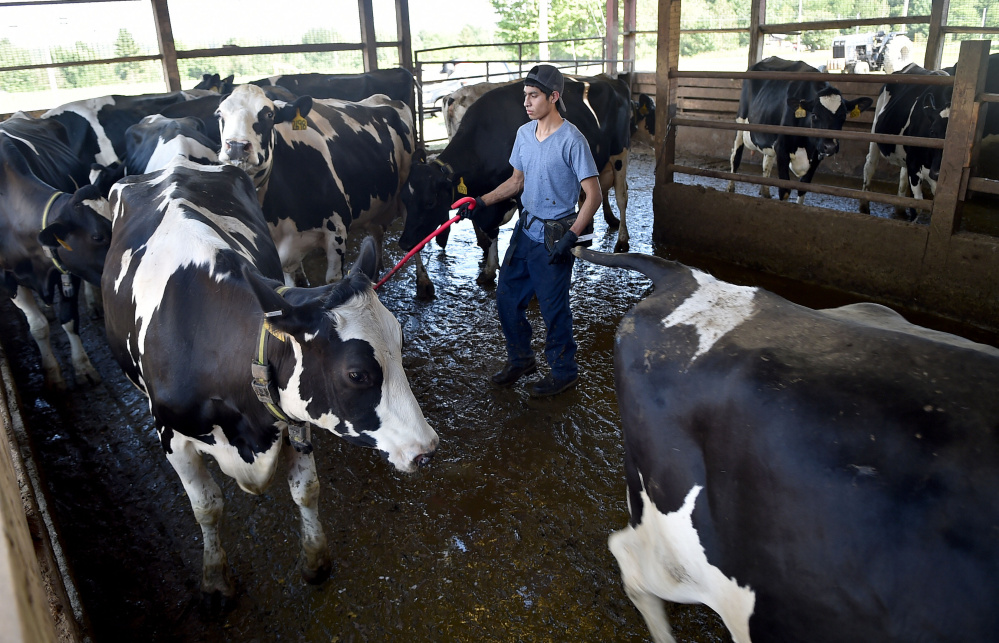CLINTON — Dairy farmer John Stoughton has increased milk production by 300,000 gallons a month this year.
“We’ve had to tighten our belts,” he said this week. “The only option for us is to produce more milk.”
Stoughton, who co-owns Misty Meadows Farm on Hill Road with his family, is reacting to a decrease in milk prices that began in 2015. And he’s not alone. From January to June, national milk production increased by 1.6 percent from the same time period last year.
More milk doesn’t mean dairy farmers are doing well, however. Farmers often increase production after government-set milk prices decrease just so they can break even.
Stoughton said Misty Meadows is one of five family-owned farms in Clinton, which calls itself the dairy capital of Maine. The town of less than 3,500 produces roughly 15 percent of Maine’s milk.
Clinton’s farmers are feeling the effects of the dropping milk prices despite state and federal aid programs.
The Maine Milk Commission uses Federal Milk Marketing Order 1 to set its monthly prices, according to Executive Director Tim Drake. The current price downswing started in early 2015, he said.
Late in 2014, the amount of milk products being exported from the United States reached a high of 17 percent. About a month ago, that number had dropped to 14 percent. Part of that is because of decreased exports to China and Russia, as well as a milk quota system in the European Union that expired in April 2015, allowing the countries to up production.
“That’s a huge swing,” Drake said. “That’s 3 percent more product nationally that has to go around.”
DEMAND IS UP, BUT PRICE SWINGS
National demand is doing well, though, Drake said. The demand for whole milk has increased, and butter and cheese remain popular.
“It could be far worse,” he said.
Still, many farmers see the milk price change over the last year and a half as a huge swing. In January 2015, the price was $21.83 per hundredweight – or hundred pounds of milk. In June, it was $16.39.
Brian Wright, who owns The Wright Place Farm on Wright Road, said he’s been struggling since 2009. When the milk price increased, he “barely got caught up” before it went down again. His farm has 750 cows. “We’re going into the unknown,” he said. “All my decisions up until a few years ago were based on history.” Now, he can’t do that anymore, he said.
Dairy farmers are compensating in the small ways they can. Many do so by producing more milk, which drives the price down even further.
Stoughton, whose farm has 1,400 acres and 1,200 animals, hasn’t made needed equipment replacements. While he’s sure prices will go up again, he thinks the cycle of ups and downs is getting sharper.
“It’s been very drastic drops compared to what we used to see,” he said.
Even the largest farm in Maine, which has 3,400 cows and is milking 1,700, is feeling the pressure from the price drop. Flood Brothers Farm on River Road hasn’t even gotten the cost of production out of its milk over the past year, said Jenni Tilton-Flood, a farm family member.
“When things get tough for dairy farms, they actually get tough all over,” she said.
SHARPER UPS AND DOWNS
Tilton-Flood said they’ve seen the volatility of the milk price increase recently, and it’s been frustrating.
“It is a roller coaster ride,” she said. “It’s very hard to get your feet on solid ground.”
The state has legislation aimed at helping dairy farms stay afloat when the milk price drops. The dairy stabilization act gives farmers a certain amount of money based on what dollar weight they’re getting for their milk and their farm’s size, said Maine Farm Bureau Executive Director Alicyn Smart.
The U.S. Department of Agriculture also announced the largest payment rate for dairy farmers enrolled in the margin protection program for dairy on Thursday.
“Any help is going to be tremendous for these dairy farms,” Smart said. But it’s hard to say if this will alleviate the problem, she said, because farmers could use the money to buy more cows, produce more milk and drive prices down further.
Madeline St. Amour can be contacted at 861-9239 or at:
mstamour@centralmaine.com
Twitter: madelinestamour
Send questions/comments to the editors.



Success. Please wait for the page to reload. If the page does not reload within 5 seconds, please refresh the page.
Enter your email and password to access comments.
Hi, to comment on stories you must . This profile is in addition to your subscription and website login.
Already have a commenting profile? .
Invalid username/password.
Please check your email to confirm and complete your registration.
Only subscribers are eligible to post comments. Please subscribe or login first for digital access. Here’s why.
Use the form below to reset your password. When you've submitted your account email, we will send an email with a reset code.